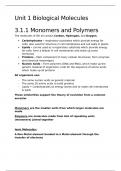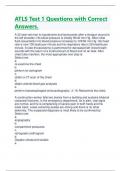Summary
Summary COMPLETE Biological Molecules Unit 1 A-Level Biology AQA
- Institution
- AQA
Comprehensive Overview: The Biological Molecules Unit 1 A-Level Biology AQA document is an expertly crafted, in-depth resource designed to guide A-Level Biology students through the foundational concepts of biological molecules as outlined in the AQA specification. This comprehensive guide provide...
[Show more]












